Gupta D. (Ed.). Diffusion Processes in Advanced Technological Materials
Подождите немного. Документ загружается.

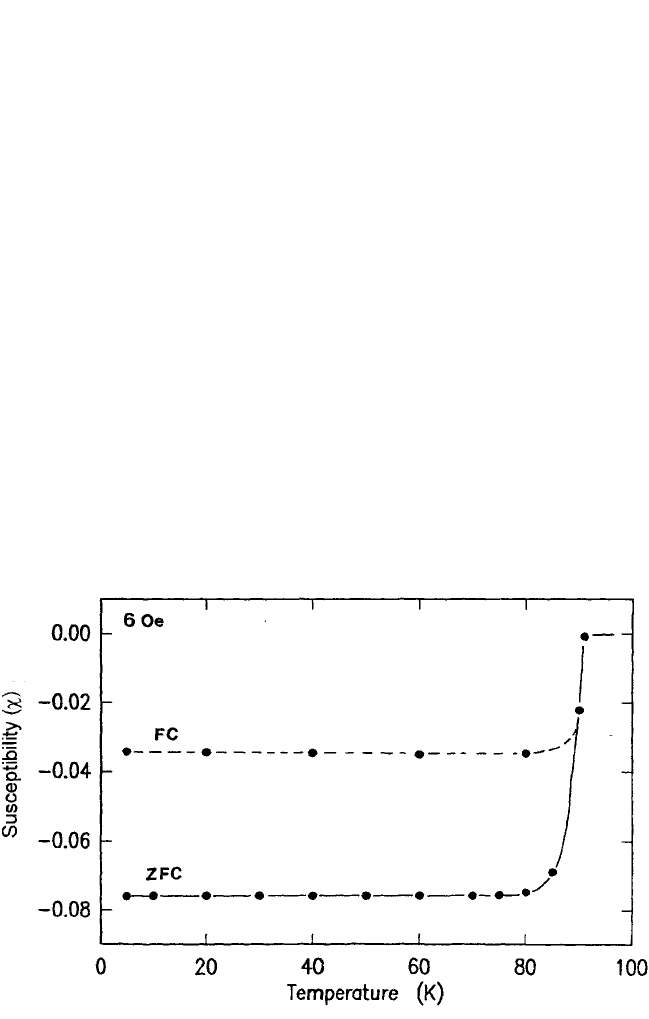
have become active. In this section, we show the role of microstructure on
cation diffusion in polycrystalline bulk YBCO, the epitaxial thin films,
which are free from grain boundaries but may still contain dislocations,
and the truly single-crystal specimens.
Figure 10.1 (pg. 491) shows the microstructure of the bulk polycrys-
talline YBCO specimens sintered at 960°C in 1 bar pressure of pure O
2
where a density fraction greater than 95% was obtained with a stoichiom-
etry of 6.9, that is, x 0.1. Large grains with plate shapes of 5 to 10 mm
diameter are seen,
[7]
and there is no evidence of any porosity left due to
any incomplete sintering. The susceptibility versus temperature behavior
of these bulk specimens is shown in Fig. 10.2(a), where a T
c
of 88 K is
observed. Cation diffusion has also been measured in the epitaxial YBCO
thin films grown on (100) SrTiO
3
substrate by the ex situ metal oxidation
technique.
[12]
In Fig. 10.2(b), superconducting transformation in such a
film is shown at a T
c
of 90 K.
[6]
Figure 10.3, taken from LeGoues,
[13]
shows a transmission electron
microscopy (TEM) cross section of the epitaxial YBCO thin film
deposited on (100) SrTiO
3
substrate. No grain boundaries are observed in
these films; however, the structure did contain misfit dislocations, which
492 DIFFUSION PROCESSES IN ADVANCED TECHNOLOGICAL MATERIALS
Figure 10.2(a) Susceptibility (c) vs. temperature curves for a thin-plate-shaped
YBa
2
Cu
3
O
7x
specimen (demagnification factor 0). The zero-field-cooled (ZFC)
curve shows close to 100% shielding, confirming the single-phase nature of the
specimen, and the field-cooled (FC) curve shows about 30% Meissner effect.
[7]
Ch_10.qxd 11/12/04 4:32 PM Page 492
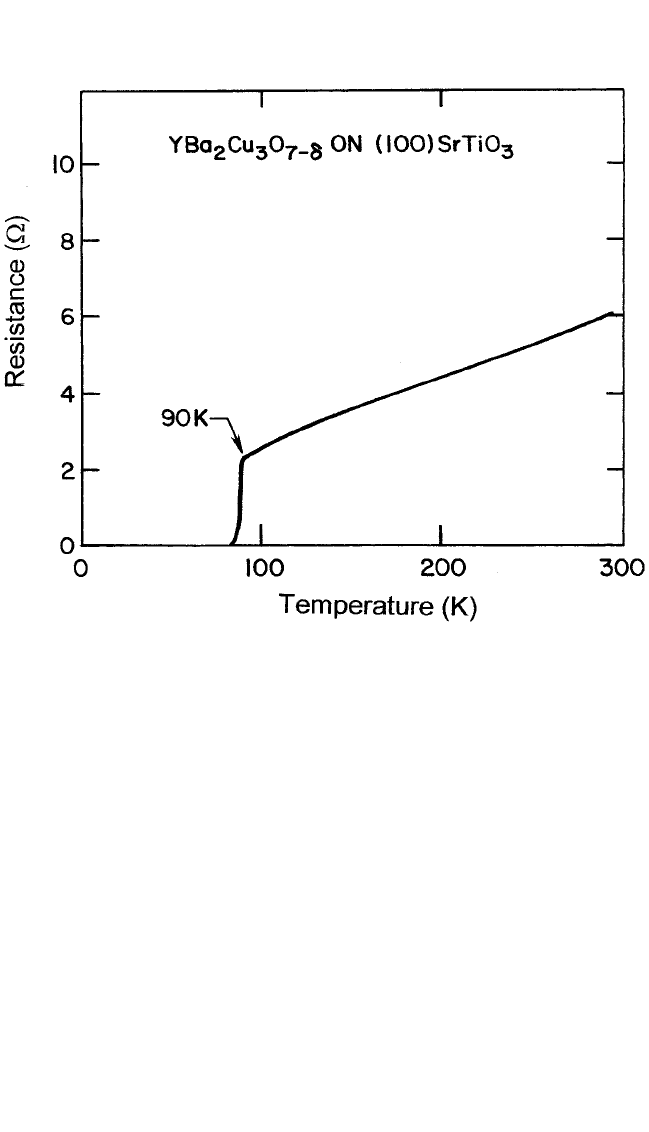
DIFFUSION IN SOME PEROVSKITES, GUPTA 493
were fully characterized. An additional variable to consider is the possible
diffusion and reaction of the HTSC film with the substrate material, which
is likely to affect its diffusion. All these issues are considered in Sec. 10.2.2.
10.2.2 Diffusion and Interactions Between YBCO
Thin Films and Substrates
As mentioned above, there is always a concern about the extent of
dissolution of the substrate materials into the superconducting films dur-
ing deposition, which involves physical vapor deposition of the con-
stituent metals followed by oxidation at high temperatures or alternative
techniques such as sputtering and laser ablation. All these processes may
involve high-temperature annealing. This problem has received wide
attention because, in general, degradation of T
c
and the critical current J
c
may be expected. We mention a few important findings here.
Figure 10.2(b) Temperature vs. resistance curve for the as-prepared YBa
2
Cu
3
O
7x
superconducting epitaxial film on (100) SrTiO
3
substrate.
[6]
Ch_10.qxd 11/12/04 4:32 PM Page 493
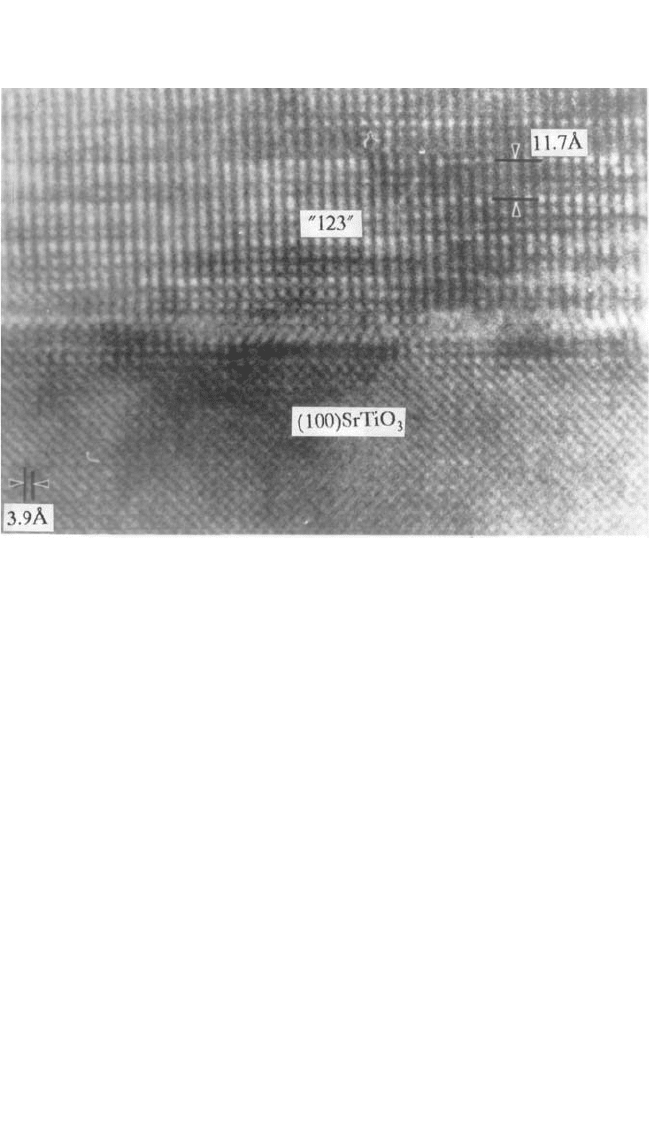
Interdiffusion and interfacial reactions between the sputter-deposited
YBa
2
Cu
3
O
7–x
thin films on MgO, sapphire, quartz, and Si substrates has
been studied by Nakajima et al.
[14]
using Rutherford backscattering spec-
troscopy (RBS) at 876 to 1226 K. All the constituent metals of YBCO
were found to diffuse and react with the substrates, although at variable
rates. Cu was reported to diffuse into the substrates at the fastest rate, and
the MgO substrate was found to be the most stable thermally. Madakson
et al.
[15]
studied diffusion in La
1.8
Sr
0.2
CuO
4
and YBa
2
Cu
3
O
7
supercon-
ducting thin films deposited by dual-ion-beam sputtering on Nd-YAP,
MgO, SrF
2
, Si, CaF
2
, ZrO
2
-9%Y
2
O
3
, BaF
2
, Al
2
O
3
,and SrTiO
3
substrates.
The films were characterized by RBS, resistance measurements, TEM, x-ray
diffraction (XRD), and secondary ion mass spectroscopy (SIMS) tech-
niques. Significant substrate/thin-film interactions were observed in all
cases, accompanied by diffusion of the metal species from the substrate
into the films and, in some cases, diffusion of the thin-film components
into the substrate. The most interesting observation was in the
YBa
2
Cu
3
O
7–x
films deposited on the SrTiO
3
substrate, onto which epitax-
ial films can be readily grown.
[12]
Both Sr and Ti migrated into the film;
in addition, Ba from the film replaced Sr in the substrate. However, the
494 DIFFUSION PROCESSES IN ADVANCED TECHNOLOGICAL MATERIALS
Figure 10.3 Cross-sectional TEM lattice image of the interface between (100)
SrTiO
3
substrate and YBa
2
Cu
3
O
7x
epitaxial thin film. Note the atomic registry at
the interface.
[13]
Ch_10.qxd 11/12/04 4:32 PM Page 494

DIFFUSION IN SOME PEROVSKITES, GUPTA 495
epitaxial character and the critical superconducting temperature (T
c
)
were not significantly affected during the replacement process until
about 40% Sr was incorporated into the film.
Migration of Sr atoms from the (100) SrTiO
3
substrate to YBa
2
Cu
3
O
7–x
superconducting epitaxial films was studied by Gupta et al.
[16]
as a func-
tion of temperature by using the radioactive
85
Sr marker at the interface.
Initially,
85
Sr was diffused into the (100) SrTiO
3
substrates in the 700 to
900°C range. Diffusion of
85
Sr into (100) SrTiO
3
substrate is described by
1.5 10
–7
exp(212 kJ/mol/kT) m
2
/sec (see Table 10.1). Four YBa
2
Cu
3
O
7x
films of 0.25 mm thickness were grown in the 700 to 950°C range by
metal evaporation and ex situ O
2
annealing for 8 min. onto the (100)
SrTiO
3
substrates, in which
85
Sr was previously diffused at 700°C for
Table 10.1. Cation Diffusion in YBa
2
Cu
3
O
7x
, Copper Metal, and PMN-PT
Piezoelectric Ceramic
Tracer Stoichiometry
*
D
o
(cm
2
/s) or Q Comment
**
/
No. Host (Technique) (x) D(T) (kJ/mol) Reference
1 YBa
2
Cu
3
O
7x
67
Cu,
64
Cu 0.1 D
o
4.0 255 P [7, 8]
2 YBa
2
Cu
3
O
7x
63
Ni 0.1 D
o
1.3 260 Epitaxial
film [6]
3 YBa
2
Cu
3
O
7x
63
Ni 0.1 D
o
1.0 241 P [7]
4 YBa
2
Cu
3
O
7x
T 700°C D(T) 1.9 10
15
C [8]
T 600°C
Ni (SIMS)
0.1 D(T) 1.2 10
16
C [8]
T 600°C D(T) 1.4 10
16
C [8]
5 YBa
2
Cu
3
O
7x
Co (SIMS) 0.1 D
o
14 280 P [8]
6 YBa
2
Cu
3
O
7x
Zn Ni (SIMS) 0.1 D
o
2.0 247 P [8]
7 YBa
2
Cu
3
O
7x
T 798°C D(T) 2.7 10
12
T 850°C
65
Zn
0.1 D(T) 8.5 10
12
P[8]
T 900°C D(T) 3.5 10
11
8 YBa
2
Cu
3
O
7x
110
Ag 0.1 D
o
10 227 P [9]
9 YBa
2
Cu
3
O
7x
133
Ba (SIMS) 0.1 890 P [9]
10 YBa
2
Cu
3
O
7x
88
Y(SIMS) 0.1 1000 P [9]
11 Cu self-
67
Cu Metal D
o
0.78 211 C [20]
diffusion
12 PMN-PT
110
Ag D
o
0.0034 277 C [10]
13 SrTiO
3
85
Sr D
o
0.0015 212 C [16]
*
The stoichiometry of 6.9 with x 0.1 was obtained by diffusion annealing under oxygen pressure of
10
5
Pa.
**
P: polycrystalline; C: c axis or AB plane; Epitaxial film: epitaxial film grown on (100) SrTiO
3
substrate
Ch_10.qxd 11/12/04 4:32 PM Page 495
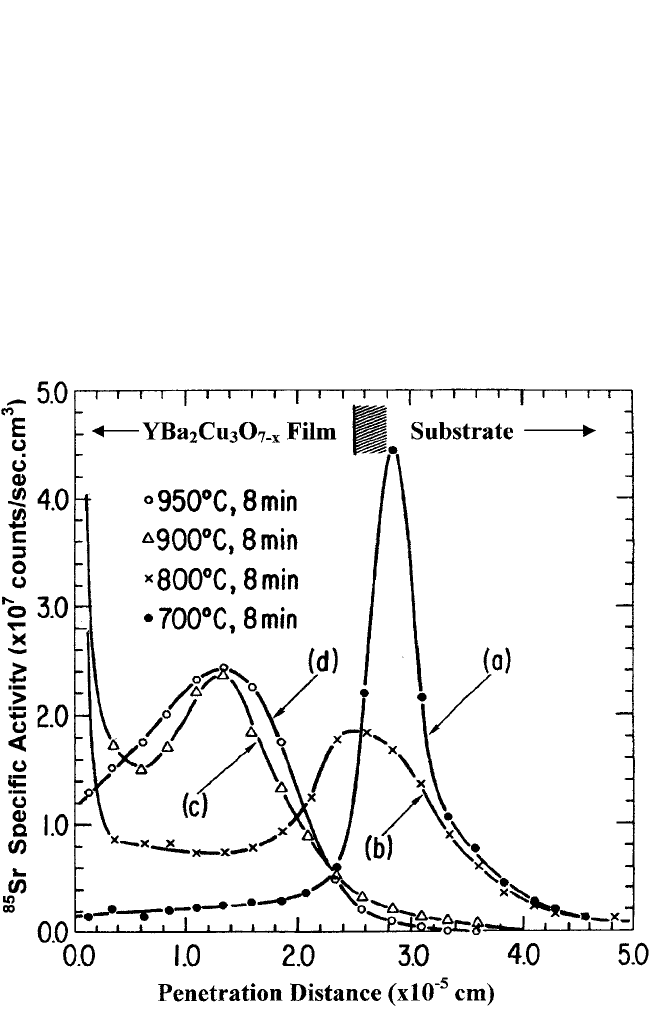
128 min. The superconducting temperatures (T
c
) were also measured at
each growth temperature. The spread of the
85
Sr tracer and Sr from the
substrate to the films was measured by sputtering with a neutral Ar atom
ion-beam generated in a Kaufman source at 500 eV and current density of
2 mA/cm
2
. The sputtered-off material was quantitatively collected. The
details of the techniques can be found elsewhere.
[11, 17, 18]
The
85
Sr tracer
profiles in the epitaxial YBa
2
Cu
3
O
7–x
films and the substrate are shown in
Fig. 10.4, which follows their growth at 700, 800, 900, and 950°C.
Temperature-versus-resistance curves for the various films are shown
in Fig. 10.5(a) and (b). In the film grown at 700°C, no superconducting
behavior was observed [Fig. 10.5(a)]. The films grown in the 800 to
496 DIFFUSION PROCESSES IN ADVANCED TECHNOLOGICAL MATERIALS
Figure 10.4
85
Sr radiotracer profiles in the epitaxial YBa
2
Cu
3
O
7x
films and the
(100) SrTiO
3
substrate interface at various O
2
annealing and oxidation conditions.
Note the progressive migration of the
85
Sr radiotracer from the substrate into the
films with increasing temperatures.
[16]
Ch_10.qxd 11/12/04 4:32 PM Page 496

DIFFUSION IN SOME PEROVSKITES, GUPTA 497
Figure 10.5 Temperature vs. resistance curves for the YBa
2
Cu
3
O
7x
thin films
deposited on (100) SrTiO
3
substrate. Prior to deposition,
85
Sr radiotracer was used
at the interface as a marker. The ex situ O
2
annealing was conducted for 8 min. in
the 700 to 950°C range. (a) At 700°C, the film did not develop superconducting
properties. At (b) 800°C, (c) 900°C, and (d) 950°C, the films became supercon-
ducting. Note that the O
2
annealing near 900°C produces the highest T
c
accom-
panied by the least resistance ratio during the transition.
[16]
Ch_10.qxd 11/12/04 4:32 PM Page 497

950°C range showed superconducting transitions [Fig. 10.5(b)]. The
best results were obtained in the film grown at 900°C, which showed the
least electrical resistance, sharp transition, and the highest T
c
of 88 K.
The T
c
in the epitaxial films is actually almost the same as observed in
the bulk polycrystalline YBCO specimens mentioned in Sec. 10.2.1. The
accumulation of the Sr is seen to peak at about half the film thickness at
900°C following an 8-minute annealing period. The diffusion distance
traced at the peak is about the same as may be estimated by a diffusion
coefficient of 4 10
–17
m
2
/sec within a factor of 2. Alarger spread may
be due to the Sr migration in the metal evaporation phase itself. The
exchange of Ba with Sr in the YBCO epitaxial films in small concentra-
tion is believed to be not only benign but beneficial as well because the
superconducting transition is narrower and the film resistance lower.
Furthermore, the films were found to have better shelf lives against degra-
dation by atmospheric moisture.
10.2.3 Self-Diffusion of the Constituent Cations
(Y, Ba, and Cu) of YBCO
In Table 10.1, the activation energy Q and the pre-exponential factor
D
o
are listed for constituent cations (Y, Ba, and Cu) species from the stud-
ies of Gupta et al.,
[7]
Routbort et al.,
[8]
and Chen et al.
[9]
Diffusion profiles
for
67
Cu tracer in bulk YBCO are shown in Fig. 10.6. Diffusion coeffi-
cients were computed from the linear segments of the profiles according
to the Gaussian solution [see Chapter 1, Eq. (10)]. Two
67
Cu penetration
profiles show excellent linear (Gaussian) behavior at 710 and 730°C.
However, at lower temperatures, they are significantly curved due to grain
boundary contributions in these polycrystalline bulk specimens, which are
discussed in Sec. 10.4. Diffusion coefficients for
67
Cu at 618 and 585°C
could be obtained from the near-surface data points after extrapolating
and deducting grain boundary contributions.
Figure 10.7 shows the Arrhenius dependence for Cu, Ba, and Y
tracer diffusion. The Cu diffusion data from the two investigations
[7, 8]
are in excellent agreement. Among the three constituent cations in
YBCO, the magnitude of diffusion could be different due to their loca-
tions in the lattice. Cu is an important species, however, since it is the
most abundant and it is the principal current carrier in the supercon-
ducting state. It also determines many physical properties such as the
critical temperature (T
c
) and current (J
c
). As mentioned earlier, it is a key
for understanding diffusion processes in YBCO and is discussed in
detail in Sec. 10.2.3.1.
498 DIFFUSION PROCESSES IN ADVANCED TECHNOLOGICAL MATERIALS
Ch_10.qxd 11/12/04 4:32 PM Page 498
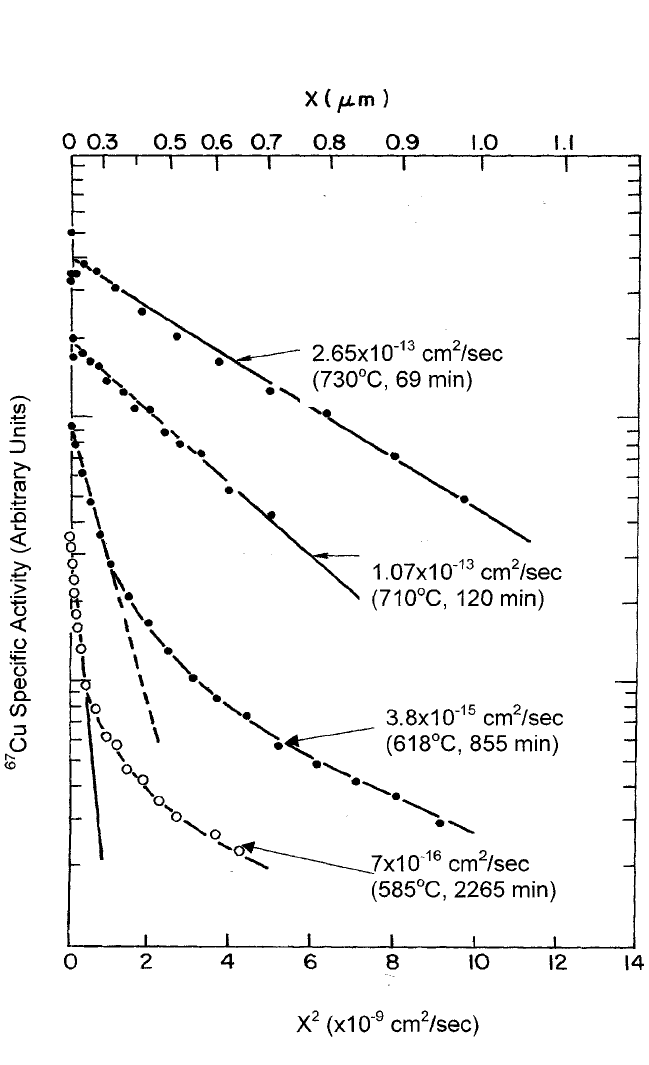
DIFFUSION IN SOME PEROVSKITES, GUPTA 499
Figure 10.6
67
Cu radiotracer diffusion penetration profiles in bulk polycrystalline
YBa
2
Cu
3
O
7x
specimens.
[6]
Ch_10.qxd 11/12/04 4:32 PM Page 499

10.2.3.1 Self-Diffusion of Cu in YBCO
A high value of activation energy for Cu cation self-diffusion of
255 kJ/mol seen in Table 10.1 in the YBCO with x 0.1 is indicative of
the absence of contributions from the oxygen vacancies present in the
basal plane. We will examine the sites in the YBCO lattice, which are
likely to be involved in the Cu cation diffusion process.
In Fig. 10.8, the various sites in the YBCO lattice are shown from
the neutron diffraction studies reported by Jorgenson et al.
[19]
It was
500 DIFFUSION PROCESSES IN ADVANCED TECHNOLOGICAL MATERIALS
Figure 10.7 Arrhenius plots Diffusion of
67
Cu, Ba, and Y tracers in bulk polycrys-
talline YBa
2
Cu
3
O
7x
specimens in 1 bar O
2
pressure.
[9]
Ch_10.qxd 11/12/04 4:32 PM Page 500
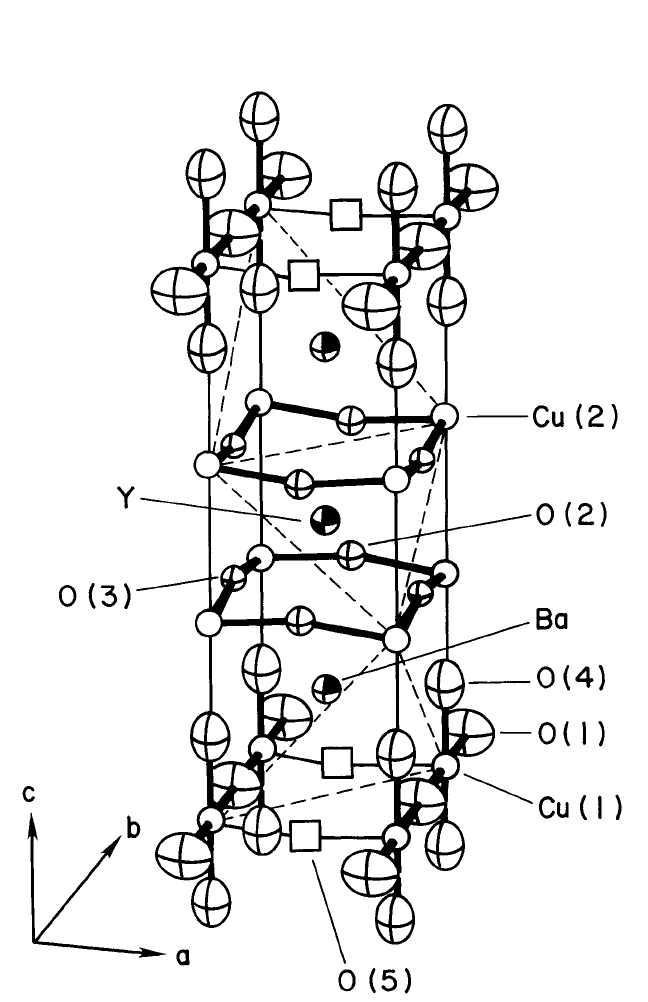
DIFFUSION IN SOME PEROVSKITES, GUPTA 501
Figure 10.8 Structure of YBa
2
Cu
3
O
7x
in the orthorhombic phase. Possible
diffusion-jump directions of the 110 and 301 types for Cu and homovalent-
cation impurities replacing Cu are shown by dashed lines; the other crystallo-
graphic multiples are not shown. After Jorgensen et al.
[19]
Ch_10.qxd 11/12/04 4:32 PM Page 501
